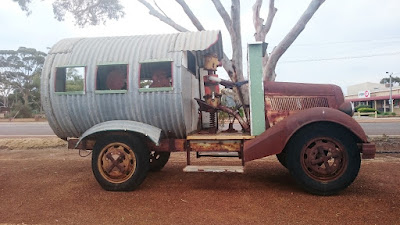The Nullarbor Plain has always, in my mind, assumed mythical
proportions, the enormous space linking east and west in Australia.
Consequently I had many preconceptions about it that remained to be
tested. And they certainly were.
1. The Nullarbor covers much of the distance between
Norseman and Ceduna.
Incorrect. The treeless part that is actually the Nullarbor
is only about 100km or so.
 |
| It is flat and treeless at Nullabor Roadhouse |
2. It is remote and a lot of planning required.
Incorrect. The maximum distance apart of any 2 places is
about 150 km. There is is fuel and accommodation at each place, and basic
necessities can be bought.
 |
| Lots of road trains service these communities |
 |
| Cocklebiddy has a sense of humour |
 |
| Some of the population |
3. It is dry.
Incorrect for us. It rained part of every day we were there,
and in some places it had rained heavily and everything's slushy and muddy. I
know it isn't always like that.
4. It is a flat and treeless expanse.
Incorrect. Much of the distance has very good plant cover,
often with large trees. Plants are not sparse. Neither is it flat.The Fraser
Range is near Norseman, and the Hampton Tablelands follows the coast for about
200km near the SA border. Much of the rest is undulating. However the Nullarbor
does have the longest stretch of road without a bend. Known as the 90 Mile
Straight it is 146.6km long.
 |
| One of the many hilly and not so treeless places |
 |
5. The wind will be behind us, blowing from the west, so we
will make good time and have better fuel consumption.
Incorrect. The wind blew a gale from the south, and judging
from the wind shaped trees, it usually blows from the south. There is nothing
between the Nullarbor and Antarctica,
and it was obvious from the temperature.
6. It might be boring.
Incorrect. There are things to see at most of the
roadhouses, and at places along the Great Australian Bight. There is also the
Nullarbor Links Course, the longest golf course in the world, which required 15
stops after Kalgoorlie. Two perhaps 4 of the holes were okay, but the rest were
"goat tracks".
 |
| The Bunda Cliffs are stunning |
 |
| The Nullabor Links Course |
As most of my preconceptions were shown to be wrong it was
an interesting trip. Some of the most memorable aspects were:
The campground at Fraser Range Station which had a fully
equipped camp kitchen with all utensils, plates etc, slow combustion stove, TV
and all the comforts of home. Fantastic on a cold wet night.
We stayed at Old Koonalda Station, an abandoned property in
a National Park. The road in was in a fairly poor state with lots of mud and
puddles, and no signage, so we were a bit surprised to actually find it. It was
a bit of an adventure into the relative unknown. The shearers quarters had a
fireplace and with 2 other couples we had a very convivial evening around the
fire and out of the wind.
 |
| Home comforts and a place for the empties as well |
Another high spot was the Old Telegraph Station at Eucla,
slowly being covered with sand. We decided to take a short walk out to the
beach. After 20 minutes trudging throughout sandy track we reached the water
and the remains other old jetty. David put his hands in the water, declared it
very cold, then we walked back through the sand.
Another beautiful spot was Fowlers Bay. It was settled by
1840, which is very early by WA standards, and Edward John Eyre set off from
there when he walked across the continent to Esperance in 1841. Today it is a
village in decline, but has great fishing, and usually a lot of whales. We did
a whale watching cruise but there were none there. We did see NZ fur seals and
Australian sea lions, and a few little penguins. It was a pity as there was a
camera crew on board from a caravan magazine, so they missed out as well.
 |
| Approaching the town you first see these magnificent dunes |
 |
| However they are steadily encroaching on the town |
 |
| The Jetty |
 |
| An Australian sea lion on display |
After Fowlers Bay we stopped at Smoky Bay. Nice sunset and cheap oysters, $8 a dozen.
 |
| Smoky Bay swimming pool and town |
 |
| Bringing in the oysters |
 |
| A final sunset over the water |
Streaky Bay was next where the highlights were the whistling
rocks, blowholes in the making, making a lot of noise. The town has numerous
historic buildings but is unusual in that it has several seats on the footpath
which honour significant women in the community. One of these was an early
midwife with an excellent record of never losing a mother.
 |
| The boardwalk to the whistling rocks and blowholes |
 |
| The coastline nearby. The holes weren't blowing, and whistles don't show up well |
Our final night was spent at another disused farm, this time outside Wudinna with its beautiful monument to the Australian Farmer. We parked
the camper in a farm shed with other machinery and an old caravan and had a
very welcome fire as well. The farmhouse is left unlocked for travellers to
explore and in 3 years hasn't been
damaged. A beautiful sunset as well.
 |
| This stunning sculpture was paid for by public subscription |
 |
| The end of a long trek across 2 states |





















































